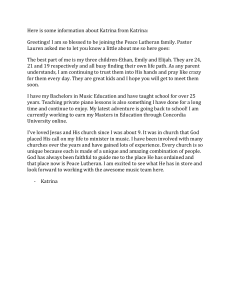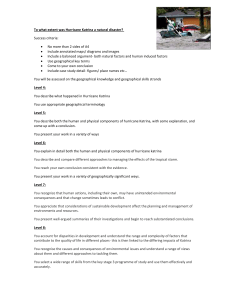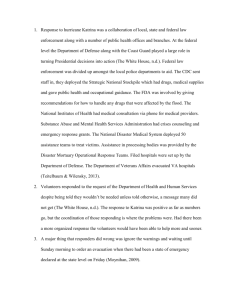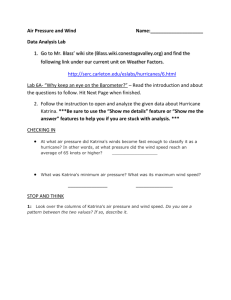federal-state-local collaboration for disaster management
advertisement
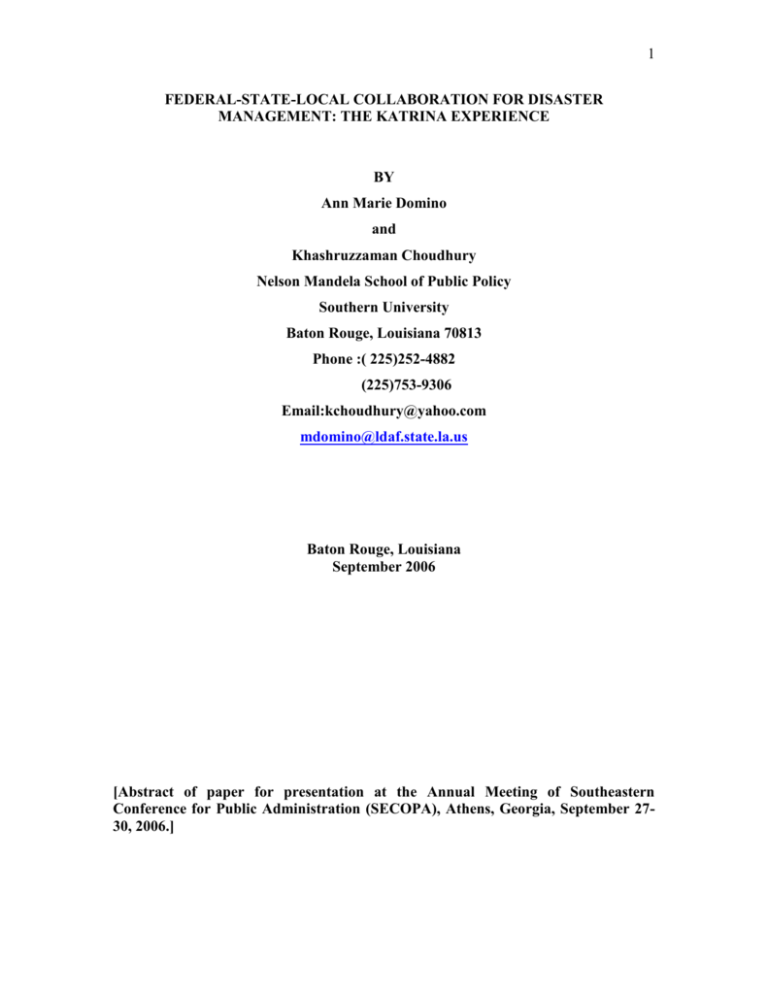
1 FEDERAL-STATE-LOCAL COLLABORATION FOR DISASTER MANAGEMENT: THE KATRINA EXPERIENCE BY Ann Marie Domino and Khashruzzaman Choudhury Nelson Mandela School of Public Policy Southern University Baton Rouge, Louisiana 70813 Phone :( 225)252-4882 (225)753-9306 Email:kchoudhury@yahoo.com mdomino@ldaf.state.la.us Baton Rouge, Louisiana September 2006 [Abstract of paper for presentation at the Annual Meeting of Southeastern Conference for Public Administration (SECOPA), Athens, Georgia, September 2730, 2006.] 2 ABSTRACT This paper examines critical issues involving federal-state-local collaboration for disaster management, drawing upon the Katrina experiences. After the listing the important literature on these issues including government reports, the paper outlines the requirements of an effective collaboration model. The paper then identifies deficiencies observed and experienced during Katrina on federal-state-local collaboration. The most important finding of the paper is that collaboration on theory and practice was completely lacking in almost all phases of the disaster management cycle: risk assessment and remedial actions, comprehensive pre-disaster planning, and post-disaster rescue, relief and rehabilitation operations. 3 FEDERAL-STATE-LOCAL COLLABORATION FOR DISASTER MANAGEMENT: THE KATRINA EXPERIENCE Introduction Hurricane Katrina, a category four Hurricane and in U.S. history, struck the golf coast on August 29, 2006. Katrina unleashed unprecedented death and destruction: over one thousand people lost their lives; properties worth about $200 billion were destroyed; the total area devastated in Louisiana, Mississippi and Alabama, 93010 square miles equaled the size of Great Britain; the debris from Katrina, if stacked onto the space of a football field, would have reached over ten and a half miles high! Federal Government, Louisiana State Government, New Orleans City Government, other Louisiana parish governments, alongwith many other governmental and nongovernmental agencies and organizations(e.g. Federal Emergency Management Agency(FEMA),Red Cross, Walmart, the Coast Guard)were involved in the management of the Katrina disaster, covering the entire disaster management cycle beginning with pre-disaster planning and preparedness and ending with post-disaster rehabilitation, which has not yet been completed. Despite massive preparations, previous knowledge and experience, and detailed emergency management plans and programs, Katrina brought to the surface and demonstrated alarming interagency co-ordinations/cooperation/collaboration problems which seriously impeded disaster management functions, especially pre-disaster evacuation and post-disaster rescue and relief operations. Although theoretically federal, state and local governments all had their detailed emergency plans (even with earlier mock exercise experience), effective collaboration was glaringly lacking! 4 Purpose, Scope, Methodology and Literature This research is a part of a major research initiative at the Nelson Mandela School of Public Policy and Urban Affairs, Southern University, which investigates the broad issue of collaboration/co-ordination/communication amongst participant governmental and non-governmental agencies/organizations in disaster management, drawing upon the experiences gained from Hurricane Katrina. The purpose of this present paper is quite modest: We wish to examine the federal-statelocal collaboration issue for Katrina in the framework of an effective collaboration model, which identifies mistakes or lapses, and suggests improvement measures or actions. In the very brief presentation that follows, we provide mostly our findings about what went wrong in Katrina, without much elaboration. In reaching these findings and conclusions, we reviewed all important secondary data and information on the Katrina experience, including published and unpublished research papers, conference papers and presentations, reports on congressional hearings, press reports, and several government reports (especially, the White House Report titled “ The Federal Response to Hurricane Katrina : Lessons Learned.”). Although the literature on disaster, disaster management and Hurricane Katrina is vast, not many research efforts have addressed the issue of intergovernmental collaboration in disaster management. A selected list of research on such collaboration is provided under “References” at the end of this paper. A Collaboration Model Although not exactly synonymous, the terms co-operation, collaboration and coordination have generally been used to mean the same phenomenon. Winer and Ray 5 (1994) define collaboration as “--- a mutually beneficial and well-defined relationship entered into by two or more organizations to achieve results they are more likely to achieve results they are more likely to achieve together then alone”(p.24).While acceptable as a “working” definition this definition lacks some important points, involved in our warranted by , “effective” collaboration amongst national and sub-national governments. For our purpose collaboration amongst different levels of government in disaster management means co-operation amongst these agencies/organizations, based upon or mandatory provisions included in these organizations’ anti-disaster emergency management plans or programs. The reference to the three different levels of government does imply some degree of superior-subordinate relationship not necessarily incorporated in a general collaboration plan. An effective collaboration model involving three levels of government somewhat different from collaboration amongst general agencies, imply the following assumptions/requirements/features. A sharing of the belief that collaboration will deliver results which are more or better than those likely to be achieved through individual efforts. Prescription of a common governmental mission, explicitly and unambiguously states in emergency plans and documents ,which indicate and describe collaboration avenues, methods, degrees and other characteristics. Commitment of politicians and the bureaucracy to the common mission. Undertaking of all necessary and helpful measures which initiate, encourage and sustain the prescribed collaborative activities and tasks such as : creation of necessary political, administrative and logistical structures; assignments of tasks,; 6 delegation of authority; pre-disaster survey/study to determine risks and undertake preventable measures including construction; comprehensive pre-disaster planning, involving the three tiers of government; mock rehearsals of emergency plans: establishment of well defined communication channels; comprehensive planning for pre and post disaster activities involving all private or nongovernmental organizations, including first responders, non-profit organizations, faith-based organizations, and volunteers; establishment of task groups to constantly plan, rehearse, monitor and evaluate expected collaborative results. Collaboration must be a continuous, and not sporadic, activity, implying a lifelong cycle of collaboration amongst the three tiers of government, institutional and other private or/and non-governmental organizations. This “ lifecycle” of collaboration implies the following sequential stages/operations :initial planning and start-up ‘ establishment of agreements, protocols and channels; growth and institutionalization ; matured and sustainable communication and co-operation; comprehensive evaluation after “ disaster”, and reformulation of goals/objectives/methods, based upon feedback. Specific provision of an unambiguous command and control structure which takes over in the time of emergency. This structure must indicate the span of control and chain of command involving all concerned governmental and nongovernmental agencies such as the Department of Homeland Security and FEMA ; several Federal Government Departments; the Armed Forces; the National Guard; Governor; state, parish and city governments; Red Cross; first responders; nonprofit organizations; many citizen groups; volunteer groups; etc. 7 a clear “ understanding of the roles that various public, nonprofit, voluntary, faith-based and private organizations as well as private citizens play in all stages of emergency management including preventions, preparedness, response and recovery”. (Norris-Tirell, 2006). Periodic rehearsal of possible disaster scenarios to test response capacity and effectiveness, as per per-determined and prescribed strategies/participants cited in emergency plans/operational programs. A clear recognition in emergency plans/programs of uncontrollable variables operating in emergencies and best provisions for such eventualities, including the role of the media, citizen groups, and public perceptions of disaster preparedness and response efforts. Provisions of clear channels and means of communications amongst all disaster response providers, the media and general public; establishment of additional (if necessary, traditional) means of communication, with clear focal points for contacts, communications and information dispersals. Collaboration Deficiencies Displayed During Katrina The review of the relevant literature and actual study of Hurricane Katrina reveal the following deficiencies displayed during the storm and its accompanying storm surges and flooding. Some of these deficiencies have already been acknowledge on the literature especially the White House Report on federal responses. The deficiencies are presented in the framework in the framework of our model outlined above. There was no clear recognition and acknowledgement a sharing philosophy with its benefits in federal, state and local plans. 8 The common governmental mission was not highlighted or emphasized enough in emergency plans or documents, displaying the glaring lack of “ a national preparedness system: ,acknowledges by even the White House Report : At the most fundamental level, the current system fails to define federal responsibility for national preparedness in catastrophic events . Nor does it establish clear, comprehensive goals along with and integrated means to measure their progress and achievement. Instead, the United States currently has guidelines and individual plans, across multiple agencies and levels of government that do not yet constitute an ‘integrated’ national system that ensures unity of effort”. Since the common mission was not explicitly stated and crystallized, the question of commitment of politicians and the bureaucracy was never seriously contemplated and acted upon. All plans and documents lacked “a common vision for preparedness – what end states are we seeking to achieve and how do we plan t get there?” (The White House Report, Chapter 6). Although risk assessments were done, and the risks had been known for a long time, preventable levee restructuring and repairs were not undertaken. This partner should combine the various disparate citizen preparedness programs into a single national campaign to promote and strengthen citizen and community preparedness”. (Chapter 6). The worst lapse in Katrina was the dangerous absence of an unambiguous command and control structure involving all response groups, including the three levels of government. This resulted in non-utilization of resources, lying idle, and 9 non-interventions at critical times in a timely manner, leading to more deaths and destructions hen were warranted by the catastrophe. Periodic rehearsals were not undertaken; response capacity and effectiveness were thus not tested. The other deficiencies were a lack of recognition of uncontrollable variables and non-provisions of eventualities; also a lack of understanding of citizen and other response group perceptions, and provision of measures to address such perceptions/concerns, if necessary. Conclusions This brief paper addressed the critical issues involving federal-state-local collaboration for disaster management. The most important conclusion of the paper is that collaboration in theory and practice was completely lacking in almost all phases of the disaster management cycle in the case of Katrina. Although we do not provide recommendations, improvements measures and actions are clearly suggested by our review and findings. 10 REFERENCES Bardach, E. (1998). Getting Agencies to Work Together: The Practice and Theory of Managerial Craftsmanship. Washington, D.C. : Brookings Institution Press Behravesh, Nariman.2005. “The Worst Storm in U.S. History Will Have a Large Impact on the National Economy”, Global Insight, September 14. Boris, Elizabeth T. and Eugene Steuerle.(1999). Non-profit and Governmental : Collaboration and Conflict. Washington, D.C : The Urban Institute Press. Center for Economic and Social Justice, “ The Katrina Wake-up Call: A Strategy for Turning Disaster into a Twenty-First Century Model for Regional Rebirth” website file://F:\strategy%20for%20disaster%20number%204.thm Choudhury,K.(1997). “Collaboration in a Disaster Management Cycle”, unpublished paper. Congressional Budget Office, 2005, “The Macroeconomic and Budgetary Effects of Hurricane Katrina”, September 6, at http://www.cbo.gov/ftpdocs/66xx/docs6627/09-06ImpactKatrina.pdf Foster- Fn’shman, P. et. al. (2001).” Facilitating Interorganizational Collaboration: The Contributions of Interorganizational Alliances”, American Journal of Community Psychology 29(6).875-906 Gray, B. (1989).Collaborating: Finding Common Ground for Multiparty Problems. San Francisco, CA: Jossey-Bass Publishers. Norris- Tirell, D. and J. Clay. (2006). “Collaborative Planning as a Tool for Strengthening Local Emergency Management”, Journal of Public Management & Social Policy, 12.26-36 11 _________. (2006). “ Building Community Networks for Emergency Preparedness ; First Responders, Non-profit Organizations,, Faith based Organizations and Volunteers”, paper presented at the American Society of Public Administration(ASPA) Annual Conference, Denver, Colorado, April. Stehr, S. D. (2001). “Community Recovery and Reconstruction Following Disasters” in Farzmand, Ali(ed.). Handbook of Crisis and Emergency Management. New York: Marcel Dekker, Inc. The White House Report on Katrina, The Federal Response to Hurricane Katrina: Lessons Learned. 2006(March). http://www.whitehouse-gov/reports/katrina-lessonslearned/html. United States Government Accountability Office (GAO). 2006. “Hurricanes Katrina and Rita – Co-ordination between FEMA and he Red Cross Should Be Improved for the 2006 Hurricane Season”, GAO Report, GAO-06-712 Winer, M. & K. Ray. (1994). Collaboration Handbook.Saint Paul, MN : Amherst H. Wilder Foundation 12



